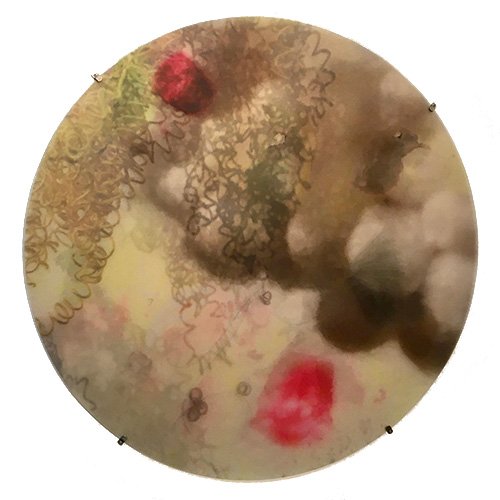Joan Robey: "On Canyon Road"
Artist Joan Robey’s practice engages in placing found objects together in assemblage. In her sculptural work, Robey uses recycled materials and combines them into a unique work of art. In her latest series titled, On Canyon Road, on view at the Lois Lambert Gallery, Robey takes photographs of natural glimpses around her desert home in Joshua Tree to create photographic collages. In every medium Robey works in, she aims to create compositions by layering fragments and creating relationships between them.
Moving away from discarded objects, Robey began this series of work by taking images of natural scenes found in Joshua Tree, where she spends some of her time. Inspired by the use of basic geometric shapes by artists Kandinsky and Malevich, Robey searches for these forms found in the natural environment of the desert. Robey is interested in investigating the changing environment of the desert, as the landscape is altered by the time of day, the seasons, and the weather conditions.
Native plants, distinct shadows, and objects moved by the wind are some of the subjects that peak Robey’s interest in her photographic stage of this process. Robey then takes these images and prints them on vellum, to mimic the final work that will be printed on plexiglas. The images are cut, layered and collaged into a rough composition which is then translated and altered digitally by erasing lines, enhancing features, and shifting the colors. Once she is satisfied with her creation, the image is then printed onto plexiglas, either on the front or back, depending on the effect she wants to create. Robey enhances the diffusion of the plexiglas by sanding down the acrylic panels on both sides before the printing process. Depending on how the work is printed, whether on the front or the back, either adds to the depth of the work or enhances the saturation of the colors.
Winter I, plexiglas, acrylic ink, vinyl, 32” x 25” x ¼”
Winter I, along with the other seasonal works in this series are printed on the front of the plexiglas to enhance the colors, which Robey likens to the colors of the changing seasons. The figure featured in center of the work is Robey’s own shadow, her version of a self-portrait. In the background, the silhouette of a tree with fruit is visible with various textures and colors layered over top. Geometric shapes and shadows overlay on top of one another to create a composition that is both dynamic and chaotic.
The Road, plexiglas, UV ink, 23” x 63”, ¼”
The road featured here is the inspiration for Robey’s show On Canyon Road. This road leads to Joshua Tree national park and influenced the use of the trees in this work. The Road is meant to mimic the harsh weather conditions that can occur in the desert, often leading objects from homes to be blown away and left somewhere else. The lower left corner of this work features a coiled object from a previous work of Robey’s which mimics the appearance of found objects in the desert brought on by strong wind.
Nesting is one of the earliest pieces made in this collection. This piece is made using two layers of plexiglas, which gives an interesting background due to the overlaying of layers. The photos were taken of sculptures that Robey has previously made. The bright red color featured in this piece came from a sculpture which featured a dozen Q-tips, two of which she painted the ends red. The coils come from another sculpture using found materials, which featured a plastic kitchen scrubbing pad which Robey disassembled to create the coils in this piece. In the upper right corner, the faint image of a bird is featured which Robey photographed outside of her kitchen window.
Nesting, Plexiglas, UV ink, 42” D x ¼”
Squint, plexiglas, UV ink, vinyl, 25” x 52” x ¼”
Squint was inspired by sunset which glows a bright orange red in the desert where Robey gets her inspiration. Due to the ink being printed on the backside of the plexiglas, this adds to the diffusion of the forms, making it seem like it is floating in water or on fire. By layering images of barren trees in a distorted fashion, this brings in the feeling of being in the desert during sundown where it is difficult to see, causing the viewer to have to squint at the sunlight.
Shadows, plexiglas, UV ink, film, vinyl, metal, 51” x 63” x 5”
This black and white noir-inspired piece gives a sense of mystery in the shapes and illusions created by these forms. Using three film sheets layered over one another, Robey mirrored the image from the plexiglas onto film and repeated the image with each layer gradually fading as they draw closer to the ground. These reflections mimic images mirrored in water. The geometric shapes in this piece are inspired by sculptures from previous shows mixed with the silhouettes of trees, cacti, and a hawk. These natural forms are repeated throughout this collection.
Joan Robey received her BFA from the University of Florida, Gainesville. Her work is included in several collections, including the Peter Norton Family Trust and Museum of Contemporary Art, Miami. She has exhibited in museums and galleries across the United States for twenty years, ranging from exhibitions at the Denver Art Museum, the Oakland Museum of California, the Orange County Museum, the LA Art Fair, and the Science World Museum in Vancouver, Canada.





